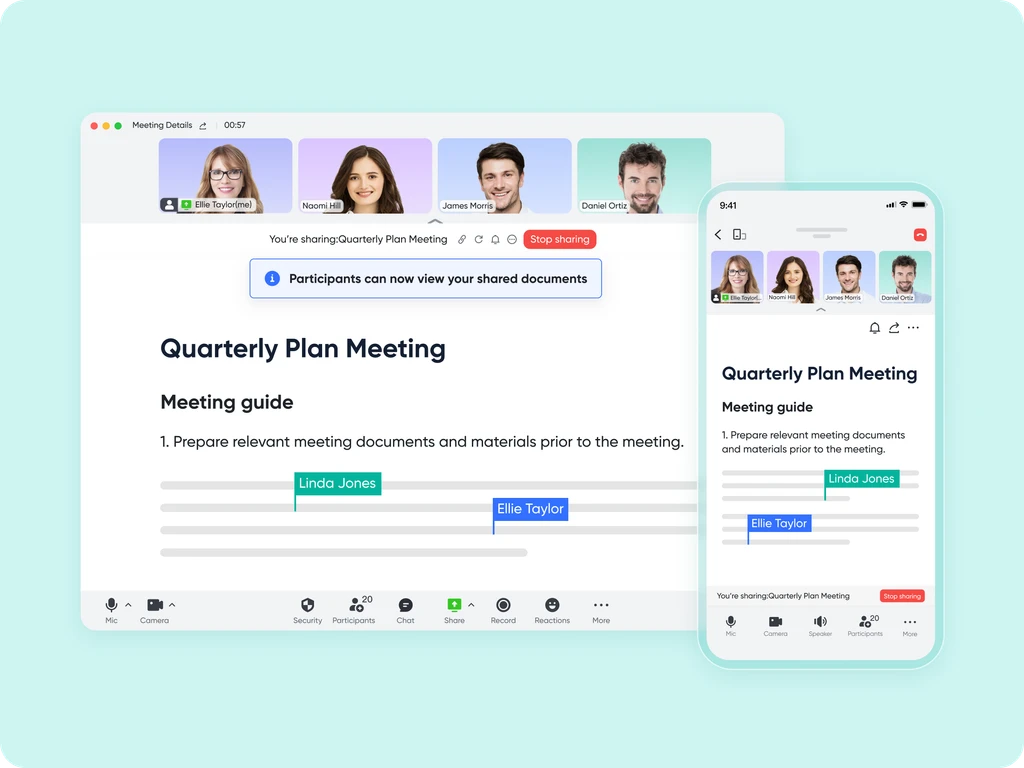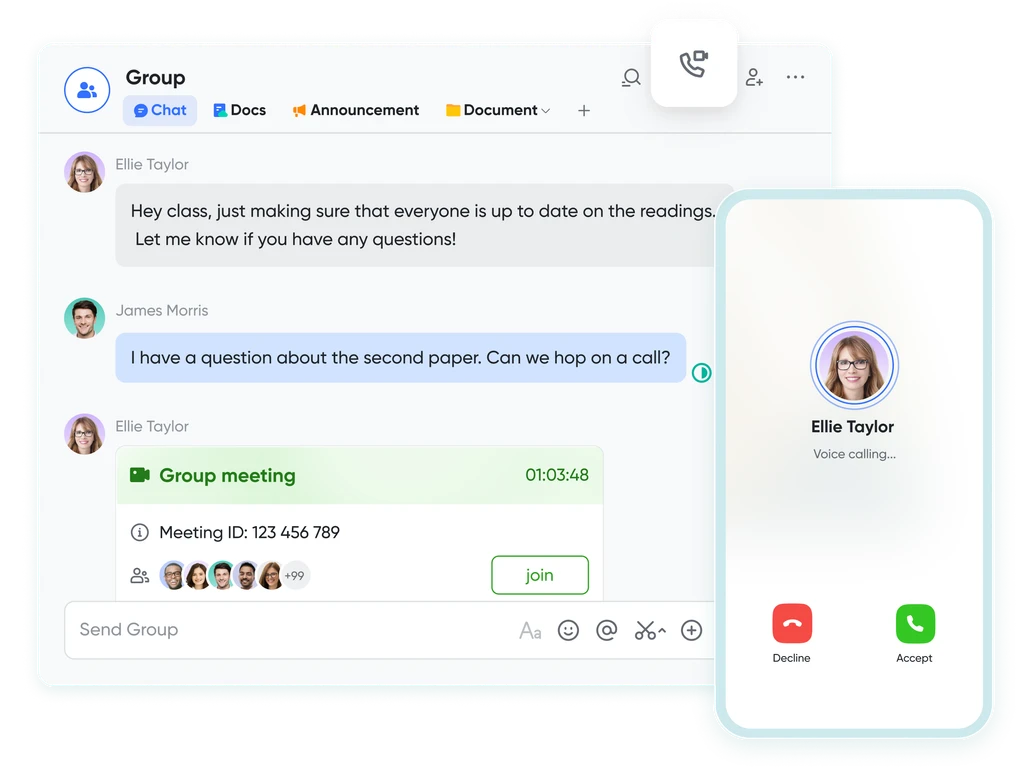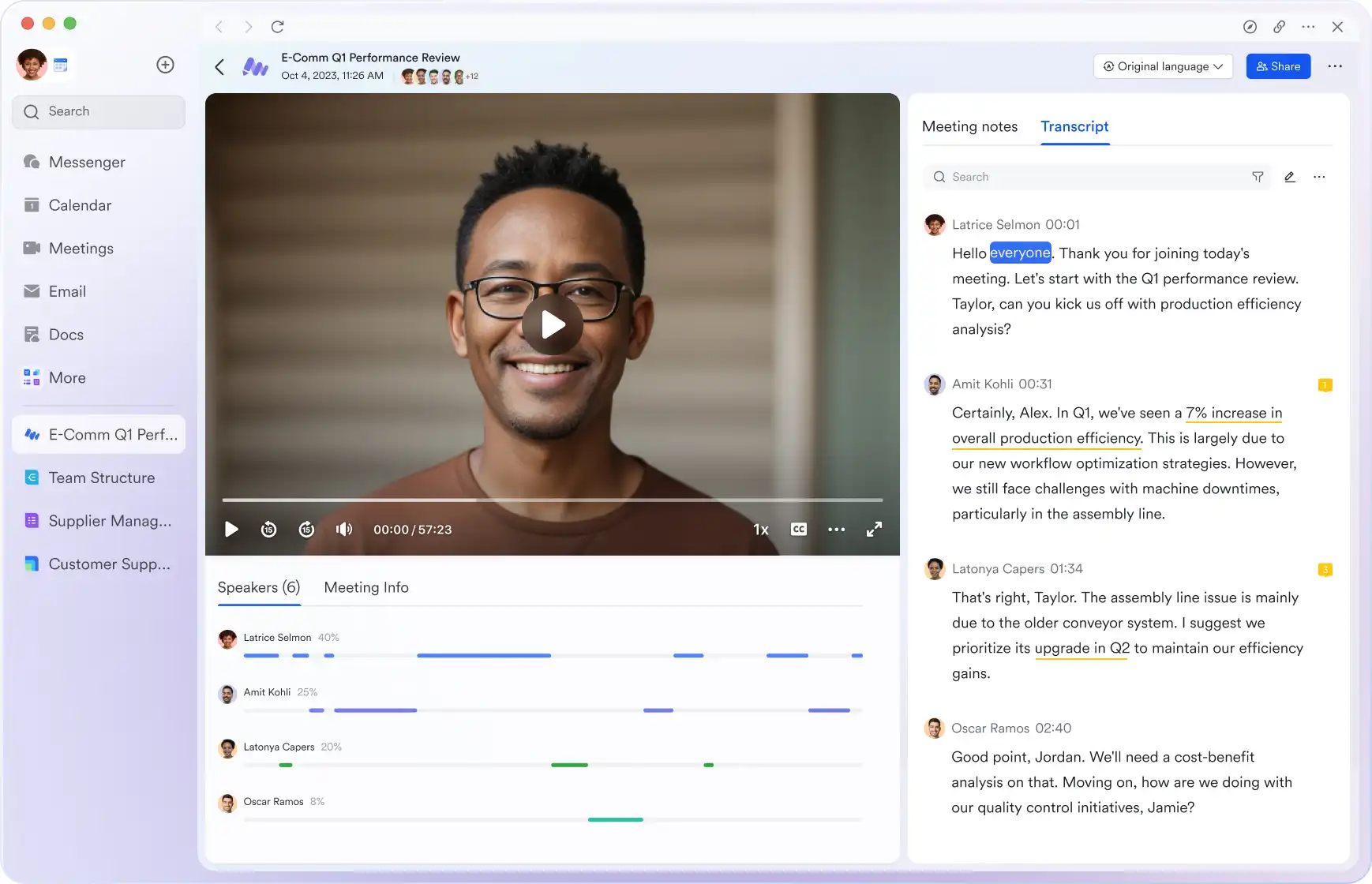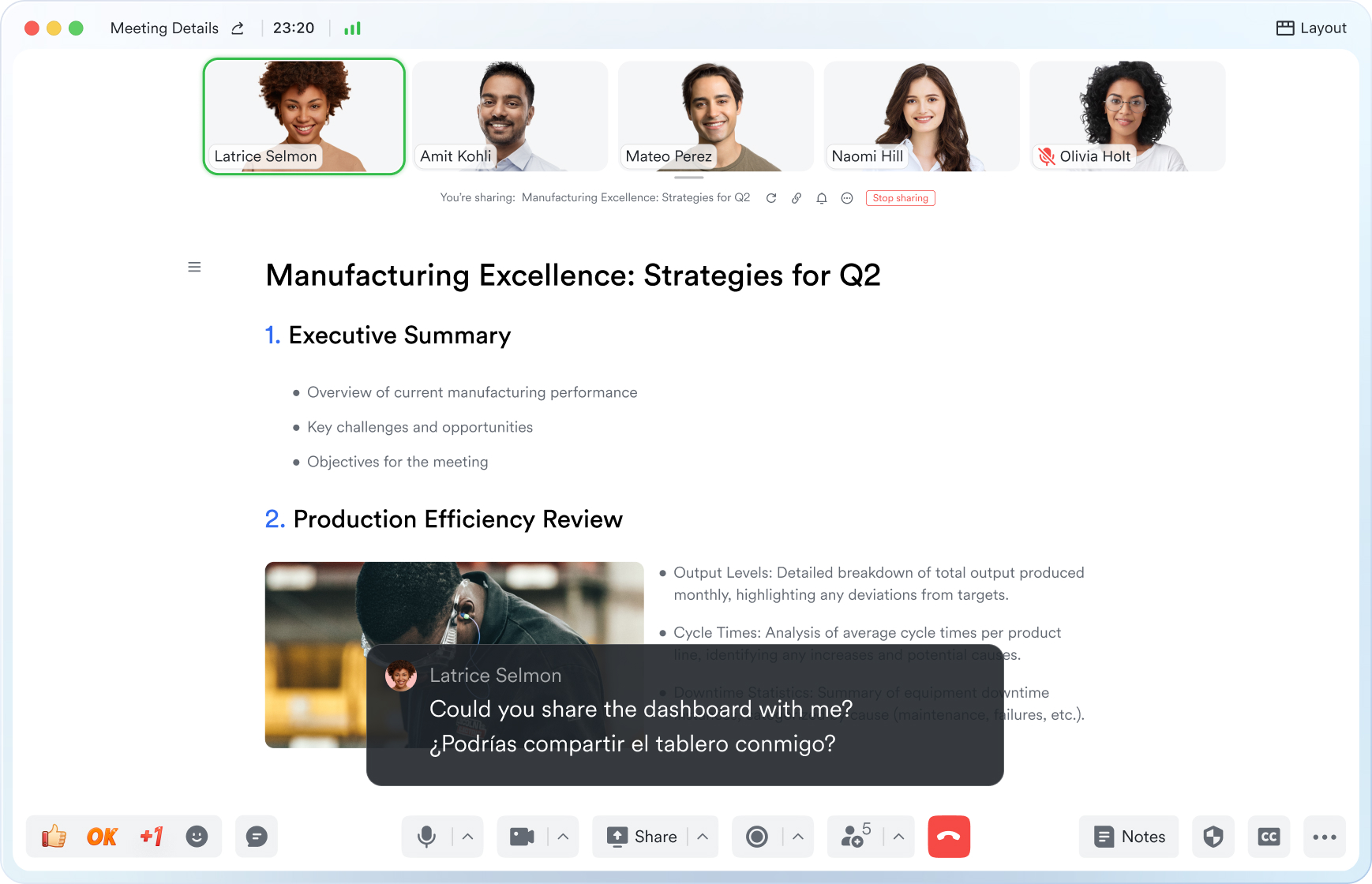Offsite Meeting
This guide will walk you through the essential elements of use offsite meeting to keep your attendees aligned and engaged.
Try Lark for Free
Off-site meetings offer a change of scenery and a unique opportunity for teams to come together, focus on important matters, and build stronger bonds. Whether you're organizing a strategic planning session or a team-building retreat, planning and executing an off-site meeting requires careful consideration and attention to detail. In this guide, we'll explore the key elements of planning and conducting a successful off-site meeting.
Use Lark Meetings to turn meetings into true collaborative experiences.
What is an off-site meeting?
Understanding Off-Site Meetings
An off-site meeting is a gathering of individuals or teams from an organization that takes place outside of the usual workplace. These meetings are typically held at external venues such as hotels, conference centers, retreats, or specific off-site locations. Off-site meetings offer a change of environment to promote creativity, focus, and collaboration.
Goals of an off-site meeting
Achieving Strategic Objectives and Team Building
The primary goals of an off-site meeting include:
- Strategic Planning: Developing or refining strategic goals and plans.
- Team Building: Strengthening team relationships, trust, and collaboration.
Who should attend an off-site meeting?
Key Participants
The composition of attendees for an off-site meeting depends on its purpose and objectives. Common participants include:
- Leadership Team: Executives, managers, or department heads involved in strategic planning.
- Project Teams: Cross-functional teams working on specific projects.
- All-Hands Meetings: All employees, for company-wide gatherings or celebrations.
Learn more about Lark x Meetings
Topics, agenda, and structure of an off-site meeting
Structuring the Meeting
A well-structured off-site meeting typically includes the following key components:
- Welcome and Introductions: Setting the tone, objectives, and introducing participants.
- Agenda Review: Reviewing the meeting agenda, goals, and expected outcomes.
- Discussion and Workshops: Addressing specific topics, workshops, or activities.
- Breakout Sessions: Small group discussions or team-building activities.
- Decision-Making: Making strategic decisions and setting action items.
- Action Item and Follow-Up: Documenting action items, owners, and deadlines.
- Team-Building Activities: Promoting team bonding and trust-building.
- Closing Remarks and Reflection: Summarizing key takeaways and expressing appreciation.
How to plan and execute an off-site meeting?
Step-by-Step Guide
Planning and executing a successful off-site meeting requires meticulous preparation and execution. Follow these steps for a productive off-site meeting:
- Define Objectives: Clearly articulate the purpose, objectives, and desired outcomes of the off-site meeting.
- Select a Venue: Choose an appropriate venue that aligns with the meeting's goals and can accommodate all participants.
- Agenda Development: Develop a detailed agenda, including discussion topics, activities, and allotted time for each segment.
- Logistics and Resources: Arrange transportation, audiovisual equipment, materials, and any required supplies.
- Communication: Communicate the agenda, logistics, and expectations to participants well in advance.
- Facilitation: Ensure skilled facilitation to guide discussions and activities during the meeting.
- Active Participation: Encourage active participation, open dialogue, and inclusion of all attendees.
- Decision-Making: Facilitate decision-making processes, ensuring that critical decisions are made and documented.
- Documentation: Assign a note-taker to document meeting minutes, action items, and key takeaways.
- Feedback and Reflection: Provide opportunities for feedback and reflection to continuously improve future off-site meetings.
- Post-Meeting Follow-Up: Share meeting minutes, action items, and progress updates with participants.
Related:
Master the Art of Meeting Notes with Lark for Enhanced Collaboration | Lark Blog | Lark BlogLearn more about Lark x Meetings
How often should you hold off-site meetings?
Meeting Frequency
The frequency of off-site meetings can vary based on organizational needs and the nature of the topics being discussed. Common frequencies include:
- Quarterly: Suitable for organizations conducting regular strategic planning sessions.
- Annually: Ideal for team-building retreats or company-wide gatherings.
- As Needed: Occasional off-site meetings in response to specific strategic or team-building needs.
Key differences between off-site meetings and similar meetings
Understanding Distinctions
Off-site meetings have unique characteristics that distinguish them from other types of gatherings:
- Change of Environment: Off-site meetings occur outside the regular workplace to encourage creativity and focus.
- Varied Topics: Topics can range from strategic planning to team bonding and development.
- Intensive Workshops: Off-site meetings may include intensive workshops, activities, or training sessions.
Learn more about Lark x Meetings
Common pitfalls of off-site meetings
Avoiding Mistakes
To ensure the success of off-site meetings, be mindful of these common pitfalls:
- Poor Planning: Inadequate preparation or unclear objectives can lead to unproductive meetings.
- Lack of Engagement: Failing to engage participants actively can result in disinterest.
- Ineffective Follow-Up: Neglecting to follow up on action items and decisions can hinder progress.
Factors for a successful virtual off-site meeting
Navigating Virtual Gatherings
In a digital era, virtual off-site meetings have become necessary for remote or distributed teams. Consider these factors for hosting successful virtual off-site meetings:
- Technology: Use reliable video conferencing and collaboration tools to facilitate online meetings.
- Engagement Tools: Incorporate interactive elements to keep remote participants engaged.
- Simulated Environment: Explore virtual platforms that provide an immersive off-site experience.
Learn more about Lark x Meetings
Typical takeaways from an off-site meeting
Measuring Success
Successful off-site meetings result in tangible takeaways:
- Strategic Clarity: Participants leave with a clear understanding of strategic goals and plans.
- Team Cohesion: Improved team dynamics, trust, and collaboration.
- Action Items: Defined tasks, responsibilities, and deadlines for implementation.
Questions to ask in an off-site meeting
Fostering Meaningful Discussions
To drive meaningful discussions during an off-site meeting, consider asking these questions:
- **What are our primary strategic goals and priorities?
- **How can we overcome existing challenges or obstacles?
- **What innovative ideas can drive our organization forward?
- **What team-building activities or exercises can enhance our collaboration?
- **How can we ensure the success of our future off-site meetings?
Related:
Unlock the Power of Webinars: A Comprehensive Guide to Boost Your Business | Lark Blog | Lark BlogLearn more about Lark x Meetings
Tools to enhance off-site meetings
Leveraging Collaborative Tools
Consider incorporating collaborative tools to enhance your off-site meetings:
- Virtual Event Platforms: Utilize virtual event platforms to create immersive off-site experiences in the digital space.
- Agenda and Collaboration Software: Use software for agenda creation, document sharing, and collaborative note-taking.
- Feedback and Survey Tools: Collect feedback and insights from participants through surveys and polls.
Examples
Real-world scenarios
Real-world scenarios
Let's explore three real-world scenarios of successful off-site meetings in various contexts:
Scenario 1: Strategic Planning Retreat
Brief Content: An organization's leadership team conducted a two-day off-site meeting at a secluded retreat center. The meeting focused on developing a new five-year strategic plan. The retreat provided a serene environment for focused discussions and team bonding.
Detailed Content: The retreat began with a welcome session, setting the stage for the strategic planning process. The agenda included in-depth discussions on market analysis, competitive positioning, and organizational strengths and weaknesses. Facilitated workshops encouraged
creative idea generation and consensus building. The retreat concluded with a refined strategic plan and a commitment to its implementation.
Scenario 2: Team-Building Weekend Getaway
Brief Content: A multinational corporation organized a team-building weekend getaway for its diverse workforce. The off-site meeting aimed to strengthen cross-cultural understanding and collaboration. Activities included team challenges, cultural exchange, and group discussions.
Detailed Content: Participants engaged in team-building exercises that encouraged communication, problem-solving, and trust-building. Cultural exchange activities allowed team members to share their backgrounds and perspectives. Group discussions focused on identifying ways to enhance intercultural collaboration within the organization. The event culminated in a shared commitment to diversity and inclusion.
Scenario 3: Project Kickoff Off-Site
Brief Content: A project management team held an off-site meeting to kick off a complex and high-stakes project. The off-site location provided a distraction-free environment for detailed planning, risk analysis, and team alignment.
Detailed Content: The meeting began with an overview of the project's goals, scope, and critical success factors. Teams engaged in risk identification and mitigation planning, addressing potential challenges upfront. Collaborative workshops allowed team members to develop a comprehensive project plan and establish communication protocols. The off-site meeting concluded with a shared understanding of project milestones and responsibilities.
Learn more about Lark x Meetings
Tips for do's and don'ts
Best Practices and Pitfalls to Avoid
Follow these do's and don'ts to ensure productive and effective off-site meetings:
| Do's | Don'ts |
|---|---|
| Clearly define the objectives and agenda. | Don't overlook logistical and technical details. |
| Engage participants actively in discussions and activities. | Avoid overloading the schedule with excessive content. |
| Facilitate decision-making and action item assignment. | Neglect to follow up on action items and decisions. |
Faqs for off-site meetings
1. What is an off-site meeting?
- An off-site meeting is a gathering that takes place at a location outside the usual workplace, often chosen for its conducive environment for focused discussions, team building, or strategic planning.
2. What is the primary purpose of an off-site meeting?
- The primary purpose of an off-site meeting is to provide a change of scenery, foster creativity, and allow participants to focus on specific objectives, such as strategy development, team bonding, or problem-solving.
3. How do you plan and organize an off-site meeting?
- Planning an off-site meeting involves selecting an appropriate venue, setting clear objectives, creating an agenda, coordinating logistics, and ensuring that participants have the necessary resources and information.
4. What types of activities are common in off-site meetings?
- Off-site meetings often include activities like brainstorming sessions, team-building exercises, strategic planning workshops, and presentations by guest speakers.
5. What are the benefits of holding off-site meetings?
- The benefits include a change of environment that promotes creativity, focused discussions, improved team dynamics, and the opportunity for participants to disconnect from daily distractions.
6. Are off-site meetings suitable for all types of organizations?
- Off-site meetings can benefit various types of organizations, from small startups to large corporations, depending on their goals and the need for a conducive environment for specific discussions or activities.
7. How can off-site meetings be made more productive and engaging?
- To make off-site meetings productive, it's essential to set clear objectives, involve all participants in discussions, and incorporate team-building activities that align with the meeting's goals.
Learn more about Lark x Meetings
Conclusion
Off-site meetings offer organizations a valuable opportunity to break away from the routine and create an environment conducive to creativity, strategic planning, and team collaboration. When thoughtfully planned and executed, off-site meetings can lead to meaningful outcomes, improved team dynamics, and a fresh perspective on challenges and opportunities.
Use Lark Meetings to turn meetings into true collaborative experiences.
A Game Changer for Offsite Meeting: Empower your team with Lark Meetings
In the fast-paced and dynamic world of modern business, effective communication and collaboration are crucial for success of Offsite Meeting. Here we introduce Lark Meetings to serve as a centralized hub for all communication needs.
Transform your meetings into collaborative endeavors

Leverage the potency of in-call document sharing, intelligent meeting minutes, and mobile-optimized features to enhance productivity collaboratively, irrespective of your location or schedule.
Seamlessly collaborate in real-time, across any device

Share live documents instead of just screen views. Participants can navigate and edit simultaneously within the video call window, even while on the move.
Shift your focus to engagement, not note-taking

Lark Minutes automatically converts video meetings into transcripts, facilitating easy viewing, searching, and collaborative editing. Stay in the loop asynchronously, even if you can't attend the live meeting. Lark Minutes for meeting minutes support translation into 10+ different languages.
Break language barriers in communication

Lark Meetings provide real-time translation for subtitles, allowing individuals from diverse backgrounds to express themselves in their native languages. Ensure every voice is heard, regardless of geographical location. Live subtitles currently support translations from English, Chinese, and Japanese to 10+ different languages. See more translation feature in Lark.
Connect with larger audiences
Host dynamic online meetings and events accommodating up to 1,000 participants, with the flexibility of up to 50 breakout sessions for intimate group discussions within the larger meeting context. Try more Lark features for free.








